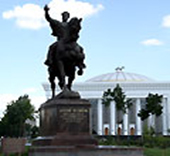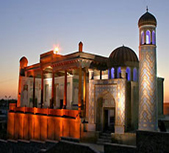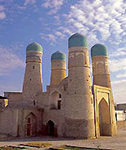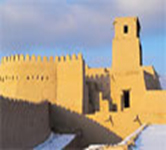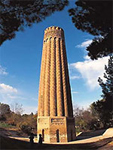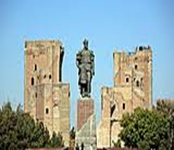|
Категории
|
Bukhara
In antiquity, Bukhara was a member of one of the states of Central Asia - Sogdiana, where already at the time of Alexander the Great town-planning structure was developed. The appearance of the city is connected with various legends and stories. In one legend tells that the son of an Iranian king Siyavush arrived in Bukhara, married the daughter of King Afrasiab and built a Ark fortress. The natural wealth of the oasis of Bukhara attracted the attention of neighboring states and foreign invaders. In the VI century BC, the Persian king, Cyrus, Darius and later captured the land of Bukhara. The domination of the Persian kings in Bukhara lasted until 330 BC
In the I century BC Bukhara was part of the Kushan state. It was one of the largest state associations in Central Asia. In the V century BC Bukhara became a part of the Ephtalites state whose capital was the city Paikend, 40 km from Bukhara. Period VI-VII centuries marked in the history of Sogdiana active process of cities building. From ancient settlements grew around Bukhara settlement Varakhsha, Vardanzi, Ramish (Ramitan), Kermine, Paikend. From the early medieval Varakhsha survives today archaeologists dug- Palace of Bukhar- Khudats (pre-arabic rulers of Bukhara), a monumental mural painting. Bukhara was a major commercial and cultural center of Central Asia. It had trade relations with Iran, India, China and other countries. In the VII century on the scene were the Arabs, who in a short time captured by Iran, Palestine, Egypt and other countries. In 709 the Arabs after the bloody assault took the city of Bukhara.
With the advent of the Arabs spread Islam in Bukhara. From that time began to be erected mosques and minarets, madrasas and religious centers. At the end of the IX Bukhara became one of the major cultural and religious centers of the Muslim world: it was called the "Dome of Islam", although from time immemorial it has been the focus of many religions and beliefs. Indeed, in the names of parts of the city of Bukhara and historical monuments reflected the location of pre-Islamic Zoroastrian temples, worshipers of the god of the moon, the Christians, Manichaeans, and finally Buddhism.
The administrative center of the city was Registan Square. There were "divans" - the main facility. The city was protected by high walls, which had 11 gates. In 999, the territory of the present Bukhara was conquered by the Turkic dynasty Karakhanids. Karakhanids ruled until 1141, then captured Bukhara new nomadic tribes - Kara-Khitay. During the reign of Karakhanids Arslan Khan (1102-1130) was built by one of the masterpieces of architecture in Bukhara - Kalon minaret. In Karahanid time in Bukhara worked for some time a prominent poet and scientist Omar Hayyam.
At the beginning of the XIII century, Bukhara became a part of the Khorezm state. In 1206 in an uprising led by Malik Sanjar. It was suppressed by the troops of Mohammed Khorezm-shah. The wealth of the oasis of Bukhara in the early attracted the attention of the XIII century the new conquerors - the Mongols. Under the leadership of Genghis Khan they conquered a large part of Sogdiana. In 1220 Genghis Khan occupied the Bukhara. Having mastered the city, the Mongols sacked it. The inhabitants were enslaved. The farms were raided.
In 1370 Bukhara became a member of the Timurid state. Bukhara lost its political importance, since the capital was the Samarkand, but remained a center of art and science. In those years in Bukhara was built Kalon Mosque, the mausoleum of Chashma Ayub and Ulugbek Madrassah.
In 1595 Bukhara khanate began to manage the new dynasty - Ashtrahanids - Khans, descendants of Astrakhan. During the reign of Sheibanids and Ashtarkhanids there is a significant upturn in the economy of the Bukhara Khanate. Most of the architecture - stunning mosques and madrassahs, caravanserais and baths, city walls and gates, as well as large architectural ensembles and tombs, which are mainly determined by the appearance of the old town were built during this period. Up to this day preserved ancient walls of the citadel, more than 140 architectural monuments of the medieval era. By the end of Ashtarkhanids Dynasty (XVIII c.) Khanate lost its economic and cultural importance. The decline of the Khanate of the economy has caused the reduction of construction in the city.
Interestingly, in the 1770s, the Russian empress Catherine the Great as a token of friendship allocated 50,000 rubles for the construction of madrasahs in Bukhara. Madrasah was named in honor of the ambassador of Bukhara Ernazar Elche. Unfortunately, it was destroyed by the Bolsheviks in 1930. In the 60-70 years of XIX century tsarist Russia's government has begun to capture the Emirate. Bukhara emirate was not prepared to wage war with Russia. The army it does not pose a serious fighting force. In 1868 Bukhara troops were finally defeated in the bloody battles of Zirabulak. As a result, was concluded peace under which Russia established a protectorate over the Emirate of Bukhara.
In 1991, Uzbekistan declared its independence. Now Bukhara - the administrative center of Bukhara region (area) of the Republic of Uzbekistan, a major economic, cultural and tourist center. Sights in Bukhara
Where else can you go to Bukhara?
|
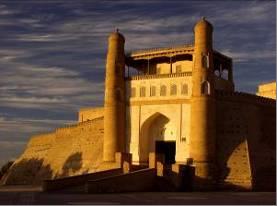 Bukhara (from the Sogdian lang. Βuxārak - "A successful, happy land," according to another version - from the Sanskrit «vi-hara» - "Monastery") - one of the oldest cities in the world. Age of Bukhara (Bukhara-i-Sharif, "Holy Bukhara") over 2500 years.
Bukhara (from the Sogdian lang. Βuxārak - "A successful, happy land," according to another version - from the Sanskrit «vi-hara» - "Monastery") - one of the oldest cities in the world. Age of Bukhara (Bukhara-i-Sharif, "Holy Bukhara") over 2500 years.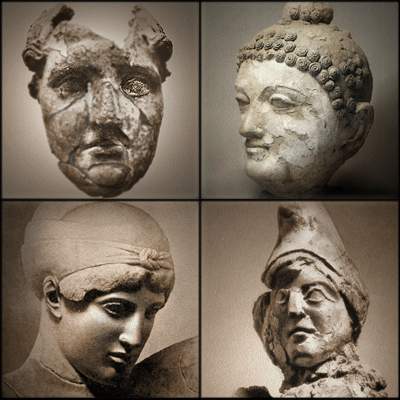 In 329 BC after the conquest of Iran by Alexander the Great, the territory of Bukhara (Sogdiana), as well as other areas of Asia, and went into the possession of the Greeks. The population has actively resisted the invaders, the rule in Sogdiana which lasted until the II century BC.
In 329 BC after the conquest of Iran by Alexander the Great, the territory of Bukhara (Sogdiana), as well as other areas of Asia, and went into the possession of the Greeks. The population has actively resisted the invaders, the rule in Sogdiana which lasted until the II century BC. The Arab domination led to popular uprisings. One of the largest uprisings of the time - under the leadership of Hashim ibn Hakim (Mukanna). This uprising became known as "The movement of people in white robes". It took a wide sweep and embraced the territory between the Amu Darya and Syr Darya. But despite the courage of the rebels, the rebellion was suppressed. However, after the uprising the local aristocracy became involved in public administration.
The Arab domination led to popular uprisings. One of the largest uprisings of the time - under the leadership of Hashim ibn Hakim (Mukanna). This uprising became known as "The movement of people in white robes". It took a wide sweep and embraced the territory between the Amu Darya and Syr Darya. But despite the courage of the rebels, the rebellion was suppressed. However, after the uprising the local aristocracy became involved in public administration.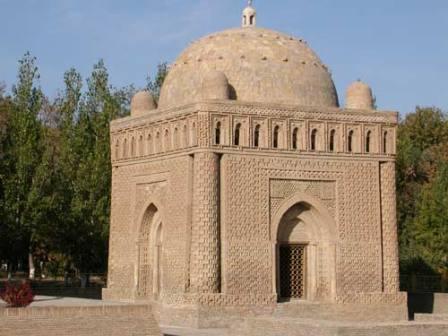 The heyday of the city began when Bukhara was chosen as the capital of the Samanids states (IX-X cc.), occupies almost the whole of Central Asia. At this time, significantly developed crafts, trade and culture. The appearance of the city itself has changed dramatically. Significantly increased the population. In the X century, Bukhara became the focus of the highest culture. It worked, many scientists are known around the world, writers and artists. Such as the historian Narshahi, poets Rudaki, Dakiki, physician and mathematician, encyclopedist, Abu Ali Ibn Sina (Avicenna) and others
The heyday of the city began when Bukhara was chosen as the capital of the Samanids states (IX-X cc.), occupies almost the whole of Central Asia. At this time, significantly developed crafts, trade and culture. The appearance of the city itself has changed dramatically. Significantly increased the population. In the X century, Bukhara became the focus of the highest culture. It worked, many scientists are known around the world, writers and artists. Such as the historian Narshahi, poets Rudaki, Dakiki, physician and mathematician, encyclopedist, Abu Ali Ibn Sina (Avicenna) and others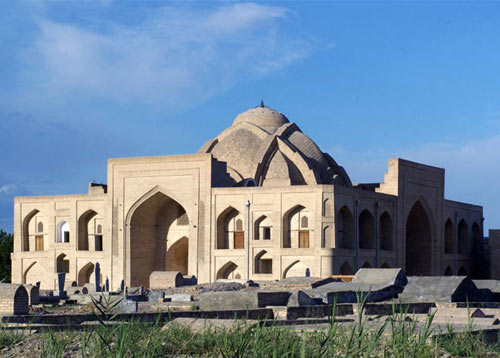 In the XII century the Bukhara oasis becomes a center of Sufism (the mystical branch of Islam) in Central Asia. One of the famous Sufis of this period was Abdulkhalik al Gijduvani. Bukhara is one of the holy cities of Islam. City remembers many of the great Sufis. One of the most revered - Bahauddin Naqshband. Mausoleum of the saint Bahaudina Naqshband is Central Asian Mecca. Here, as in Mecca, the faithful come from all Muslim countries to ask for fulfillment of desires and aversions of sins.
In the XII century the Bukhara oasis becomes a center of Sufism (the mystical branch of Islam) in Central Asia. One of the famous Sufis of this period was Abdulkhalik al Gijduvani. Bukhara is one of the holy cities of Islam. City remembers many of the great Sufis. One of the most revered - Bahauddin Naqshband. Mausoleum of the saint Bahaudina Naqshband is Central Asian Mecca. Here, as in Mecca, the faithful come from all Muslim countries to ask for fulfillment of desires and aversions of sins.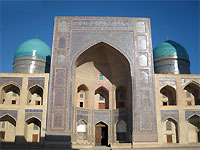 In the second half of the XIII century, Bukhara became gradually recover. Mongols began to know to convert to Islam, but some members are "murids" - disciples of Sufi sheikhs. Among them was a famous sheikh of Bukhara Sayf ad-Din Boharzi.
In the second half of the XIII century, Bukhara became gradually recover. Mongols began to know to convert to Islam, but some members are "murids" - disciples of Sufi sheikhs. Among them was a famous sheikh of Bukhara Sayf ad-Din Boharzi.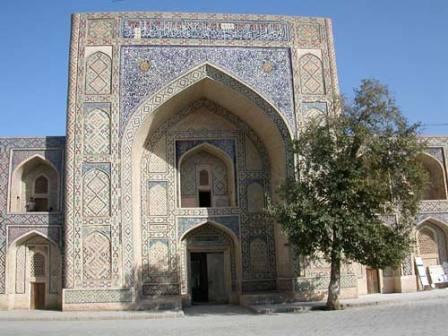 In 1506 in Bukhara, the power goes with the former - a new dynasty, which united the settled and nomadic Uzbek tribes. In the early years of the dynasty remained the capital in Samarkand. In the second half of XI century, when Abdulla Khan, Bukhara became the political center of the state, followed by the name of the “khanate” was strengthened. Abdullah Khan, during his more than forty-year reign, built a lot of schools, mosques, baths, caravanserais and bridges, shady gardens spread in major cities Khanate accept e-mail message, and in general was a zealous patron of agriculture, commerce and science. The name of Abdullah Khan, and still enjoys extraordinary popularity in Bukhara, in the eyes of Bukhara each monument of former times it seems the result of the generosity and love for the fine arts of the ruler.
In 1506 in Bukhara, the power goes with the former - a new dynasty, which united the settled and nomadic Uzbek tribes. In the early years of the dynasty remained the capital in Samarkand. In the second half of XI century, when Abdulla Khan, Bukhara became the political center of the state, followed by the name of the “khanate” was strengthened. Abdullah Khan, during his more than forty-year reign, built a lot of schools, mosques, baths, caravanserais and bridges, shady gardens spread in major cities Khanate accept e-mail message, and in general was a zealous patron of agriculture, commerce and science. The name of Abdullah Khan, and still enjoys extraordinary popularity in Bukhara, in the eyes of Bukhara each monument of former times it seems the result of the generosity and love for the fine arts of the ruler. In 1740 Bukhara captures Nadir Shah of Iran. In 1747, came to power Mohammad Rahim biy - Emir of the tribe Mangit, who became the founder of a new dynasty - Mangit. Since coming to power of the Mangit emirs, Khanate was Emirate of Bukhara. It lasted until 1920 Bukhara Emirate most of its power reached at Amir Shakhmurad (1785-1800) and Nasrullah (1826-1866), in which part of the state was part of a large part of the territory of present Uzbekistan and Tajikistan, as well as the northern part of Afghanistan and Turkmenistan . At the beginning of the XIX century, the city regained its former status as a center of Islamic religion. In Bukhara, were restored dozens of madrasas, which taught students from all over the Islamic world.
In 1740 Bukhara captures Nadir Shah of Iran. In 1747, came to power Mohammad Rahim biy - Emir of the tribe Mangit, who became the founder of a new dynasty - Mangit. Since coming to power of the Mangit emirs, Khanate was Emirate of Bukhara. It lasted until 1920 Bukhara Emirate most of its power reached at Amir Shakhmurad (1785-1800) and Nasrullah (1826-1866), in which part of the state was part of a large part of the territory of present Uzbekistan and Tajikistan, as well as the northern part of Afghanistan and Turkmenistan . At the beginning of the XIX century, the city regained its former status as a center of Islamic religion. In Bukhara, were restored dozens of madrasas, which taught students from all over the Islamic world.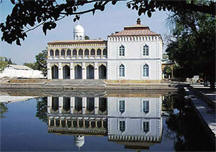 September 2, 1920 in Bukhara, a rebellion broke out, supported by the Red Army and as a result of a three-day assault on the city was captured by the rebels and the Red Army, the last Emir of Bukhara - Alim Khan deposed and fled to Afghanistan. In Bukhara has been proclaimed the Bukhara People's Soviet Republic, which lasted until 1924. After that, Bukhara, as the administrative center of Bukhara region, was incorporated into the Uzbek Soviet Socialist Republic.
September 2, 1920 in Bukhara, a rebellion broke out, supported by the Red Army and as a result of a three-day assault on the city was captured by the rebels and the Red Army, the last Emir of Bukhara - Alim Khan deposed and fled to Afghanistan. In Bukhara has been proclaimed the Bukhara People's Soviet Republic, which lasted until 1924. After that, Bukhara, as the administrative center of Bukhara region, was incorporated into the Uzbek Soviet Socialist Republic.